Related Topics
Philadelphia's River Region
A concentration of articles around the rivers and wetland in and around Philadelphia, Pennsylvania.
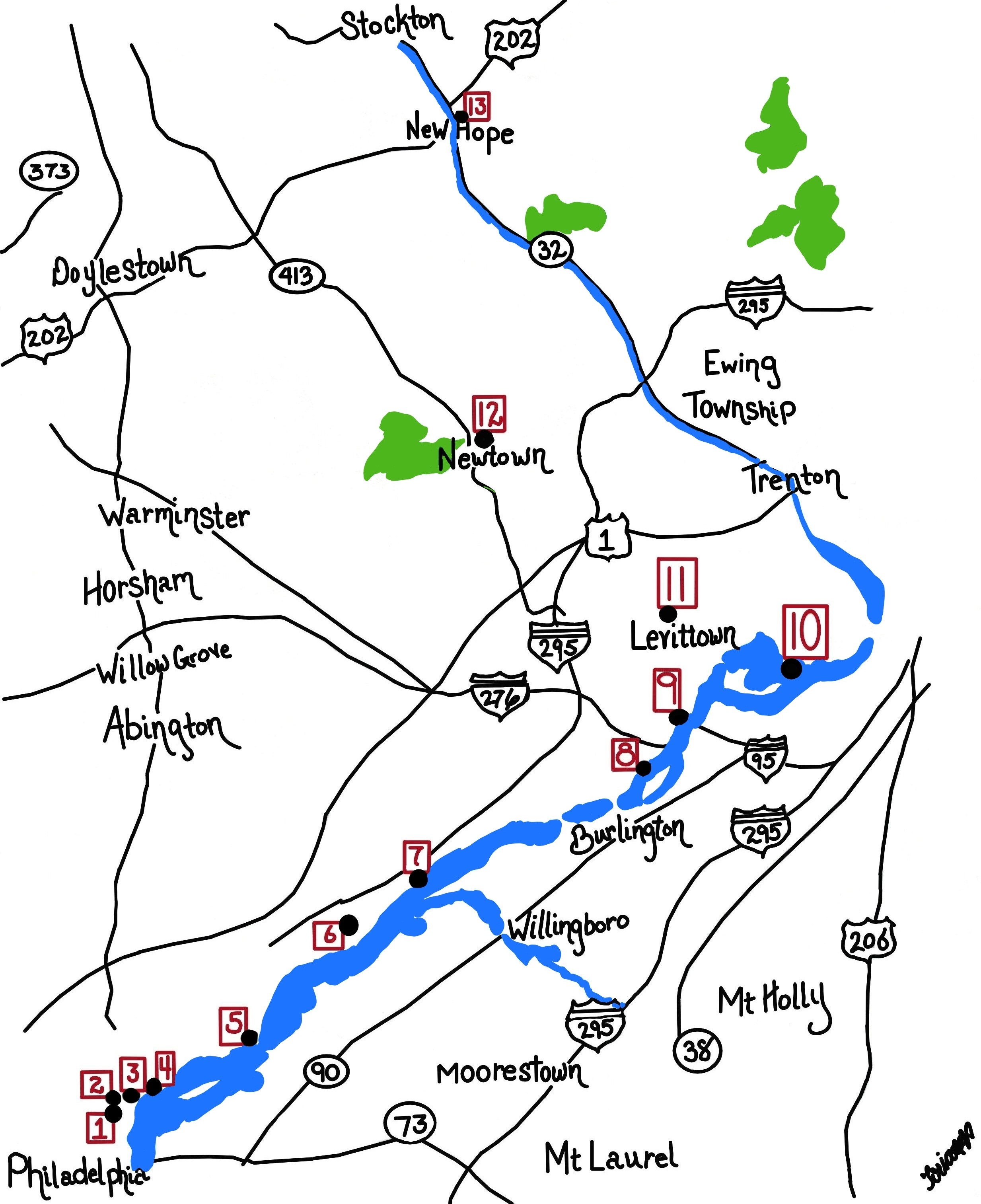
Delaware (State of)
 Originally the "lower counties" of Pennsylvania, and thus one of three Quaker colonies founded by William Penn, Delaware has developed its own set of traditions and history.
Originally the "lower counties" of Pennsylvania, and thus one of three Quaker colonies founded by William Penn, Delaware has developed its own set of traditions and history.
Philadelphia Fish and Fishing
Less than a century ago, Delaware Bay, Delaware River, Schuylkill River, Pennypack Creek, Wissahickon Creek, and dozens of other creeks in this swampy region were teeming with edible fish, oysters and crabs. They may be coming back, cautiously.
Historical Preservation
The 20% federal tax credit for historic preservation is said to have been the special pet of Senator Lugar of Indiana. Much of the recent transformation of Philadelphia's downtown is attributed to this incentive.
City of Rivers and Rivulets
Philadelphia has always been defined by the waters that surround it.
Nature Preservation
Nature preservation and nature destruction are different parts of an eternal process.
Revolutionary Philadelphia's Patriots
All kinds of people were patriots in 1776, and many of them were all mixed up about what was going on and how they stood. Hotheads in the London Coffee House stirred up about an inoffensive Tea Act, Scotch-Irish come here to escape the British Crown, the local artisan class and the local smuggler class, unexpectedly prospering under non-importation, and the local gentry -- offended to be denied seats in Parliament like other Englishmen. Pennsylvania wavered until Ben Franklin stepped forward with a plan.
Land Tour Around Delaware Bay
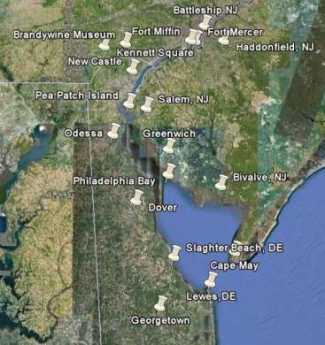 Start in Philadelphia, take two days to tour around Delaware Bay. Down the New Jersey side to Cape May, ferry over to Lewes, tour up to Dover and New Castle, visit Winterthur, Longwood Gardens, Brandywine Battlefield and art museum, then back to Philadelphia. Try it!
Start in Philadelphia, take two days to tour around Delaware Bay. Down the New Jersey side to Cape May, ferry over to Lewes, tour up to Dover and New Castle, visit Winterthur, Longwood Gardens, Brandywine Battlefield and art museum, then back to Philadelphia. Try it!
Natural Science
foo
Right Angle Club 2011
As long as there is anything to say about Philadelphia, the Right Angle Club will search it out, and say it.
Not a Single Red Knot
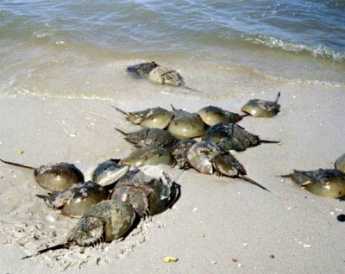
|
| Horseshoe Crabs |
A full moon brings high tide, which for centuries has brought vast numbers of horseshoe crabs to the banks of the Delaware River, toward the end of May. Marine biologists tell us these ugly-looking beasts have evolved very little for thousands of years.
Horseshoe crabs transport oxygen through their blood as a blue copper compound instead of that iron-containing hemoglobin the rest of us use. That's red, of course. Somewhere in the evolutionary path, these ancient animals also neglected to develop an immune system, but defend themselves against bacteria by precipitating sediment when they encounter endotoxin. By luck, this reaction takes place even though the bacteria are dead, so it is routinely employed as a way of detecting and eliminating endotoxin in intravenous fluids, which would otherwise go undetected by failing to grow the original bacteria in conventional culture media. Unfortunately, those of us who have never experienced a temperature spike to 106 degrees from an intravenous infusion of "sterile" water is more or less indifferent to the contribution of the Delaware crabs to our well-being. As well as being sadly indifferent to the unique nature of their nerve cells, in long single neurons, which make a number of important experiments possible.
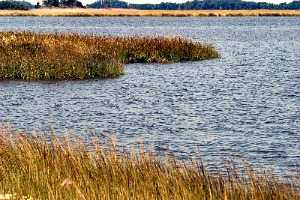
|
| Bombay Hook |
The horseshoe crab offers still other attractions. When they come ashore to lay eggs (at a full moon, or high tide, in May), they lay incredibly large quantities of them, attracting astonishing swarms of birds, which can be seen gliding a few feet above the water surface in groups of hundreds or even thousands. The Red Knot sandpiper is certainly not the only egg-eater at Bombay Hook, but there are some unique features of that bird to be mentioned in a minute. A lot of people object to being attacked by monster swarms of mosquitoes in the summer, but screens and air-conditioning have encouraged a large number of rather prosperous houses to be built along the shore, particularly where there are sandy beaches. In fact, it is so crowded the Fish and Wild Life Service has placed street lights at such public places, with a narrow driveway to lead you to the beach. If you don't know how to recognize such amenities, well, too bad for outsiders.
Although there are plenty of naturalists and bird-watchers who come in the early spring, most of the houses along "Slaughter Beach" seem to belong to fishermen and duck hunters, the two outdoor sports with most popularity. Different migrations of different food-producers bring different prey for the sportsmen, but somehow the most up-scale members of this fraternity tend to go there in May, looking for Red Knots. A Red Knot is a form of sandpiper, with a red head and breast. The birds are born in the Arctic tundra, eating vast amounts of mosquito eggs and larvae, migrating south in the fall. They winter over in Tierra del Fuego at the opposite end of the earth and then migrate north to Bombay Hook on Delaware. For these long migrations, they must eat voraciously when they do eat and somehow have learned to look for the horseshoe crab eggs at just the right time, presumably following cycles of the moon for timing. Residents of the area for centuries have remarked on the timing of the birds and the tides and the crabs. Unfortunately, the two-continent migration was only recognized fairly recently, and when the supply seemed endless, the crabs were scooped up and used for fertilizer until their supply began to dwindle; both Delaware and New Jersey now have protective legislation, and Virginia is being verbally excoriated by bird watchers, to do the same. The crabs have started to come back, but the Red Knots are slower to respond, and now the threat is Sushi. Another ecological damage has reduced the supply of crabs in the Pacific, so the crab fishermen have migrated to the Atlantic to catch the crabs as bait for conch and other ingredients of Sushi. Once again, the abundance of crabs has declined, although to a much smaller degree than the Red Knots. This year, on the very best day of the year for this sort of thing, with dozens of out-of-state license plates wandering aimlessly up and down thirty miles of shoreline, the shouted greetings among serious bird watchers returned the sad news, "No Red Knots today. Try the beach." It was generally agreed there was a bit too much wind for good Red Knot sighting, and that oil spills in the Gulf of Mexico were to be suspected, and that perhaps tomorrow would be a better day. But judging by the very expensive optical equipment these people were carrying around, these were serious birders, indeed. If they couldn't find Red Knots, the rest of us might as well give up.
The most plausible theory for the latest decline centers around the old-timer birds. When the first-timers start their northward migrations, they are guided by the old-timers who have made the trip at least once before. If something injures the flock, it may be a few years before the supply of old-timers revives enough to supply the first-timers with guides. That's just a theory, of course, but currently the most popular one. Just what it would take to eliminate the Red Knot migration completely, may now be close to being tested. Just on principle alone, it does seem a pity to eliminate a phenomenon which took thousands of years to develop.
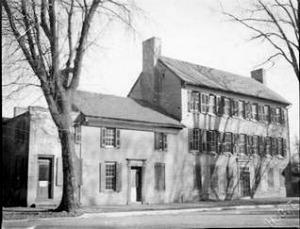
|
| Benjamin Chew's Whitehall |
When you finally give up on Red Knots, you might as well wander around this enormous wildlife sanctuary. A few miles up the road is the former location of Whitehall, the plantation house of Benjamin Chew, lawyer for the family of William Penn, and owner of the stone fortress on Germantown Avenue in Philadelphia that thwarted George Washington's attempt to stall and starve the British before they could join up with their ships in the harbor below Fort Mifflin. The original buildings on the plantation have disappeared, but the spongy plantation trails have been replaced by elevated gravel roads. So it is possible to roll up the windows of your car in mosquito season, turn on the air conditioning, and cruise around the spectacularly beautiful ponds and inlets. Further south is the plantation of Caesar Rodney, who rode to Philadelphia in the rain to cast the deciding vote for the Declaration of Independence. And further south of that is the plantation of John Dickinson, who made Rodney's ride necessary by refusing to sign the Declaration, on the grounds that the colonies showed insufficient unity, in his eyes, to be able to win a war with England. And anyway, the argument was largely economic, hence more likely to be won by economic means than military ones.
To the west of these historic plantations are some pretty impressive farms, new style. The houses give them away since no farmer will spend a cent on his house if he can profitably expand his farm; these houses belong in glossy magazines. The silos are grouped in clusters of ten or twelve, the irrigation sprinklers are a quarter-mile long, attachable to what resembles a fire hydrant in the center of the field. There are over a hundred sheds on some farms, filled with chickens fattening up. And do you know what? You can drive for miles without seeing a single chicken.
Eventually, the road leads to the Dover Air Force Base, very large indeed. No planes are in evidence, as is true on most days. But one day in 1962 Mr. Kennedy was talking to Mr. Castro, and overhead at Dover you could see dozens, maybe hundreds, of eight-engine bombers. Just circling, circling, waiting for orders to go lay an egg on the Kremlin. It wasn't clear to onlookers at the time, just what this was all about. But the idea can now be entertained that perhaps Red Knots weren't the only species flirting with extinction.
Originally published: Monday, May 23, 2011; most-recently modified: Wednesday, May 29, 2019
| Posted by: bad science | Oct 26, 2011 12:01 AM |